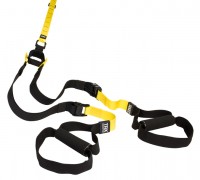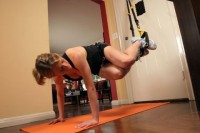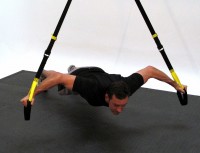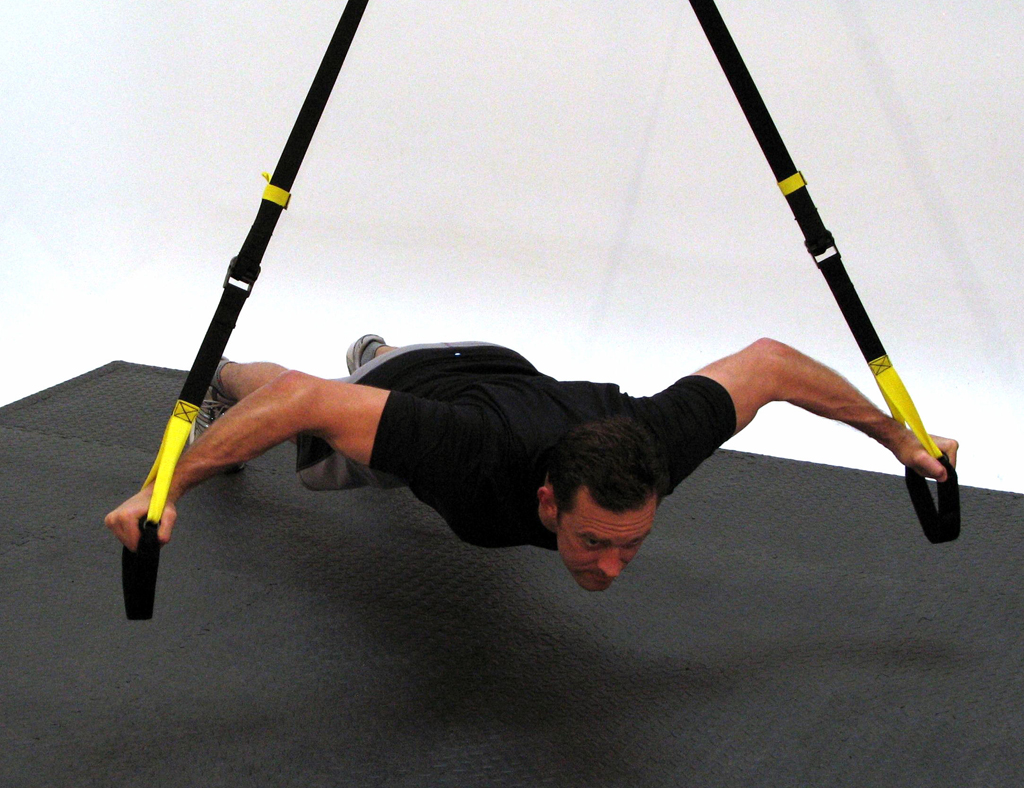 If you are lucky enough to be a member of a gym that keeps its weight training equipment up to date then you might have noticed something new in your gym that looks a bit different from all the other heavy weights and machinery that makes up most of the gear in the gym.
If you are lucky enough to be a member of a gym that keeps its weight training equipment up to date then you might have noticed something new in your gym that looks a bit different from all the other heavy weights and machinery that makes up most of the gear in the gym.
If your gym manager keeps their eye on the latest trends in the world of fitness and exercise then there is a good chance they have added some suspension straps to your gym.
But what are Suspension Straps?
If you aren’t familiar with this new type of fitness equipment don’t worry: in the coming months you are highly likely to hear lots and lots about them as two recent surveys carried out by the American Council on Exercise and the IDEA Health & Fitness Association revealed that suspension training exercises or bodyweight leverage training as it is also known will be one of the top fitness workout trends of the year with an ever growing presence in gyms and the repertoires of personal trainers. To break it down for the uninitiated these straps are pieces of weight training equipment that allow the user to perform bodyweight leverage exercises.
But what are suspension training exercises I hear you ask?
 Well that is a good question and as the name suggests they are exercises that are performed while your body or parts of it are suspended above the ground. Now if you suffer from vertigo don’t worry! When performing this type of exercise there is no need to go higher than a few inches or feet at the most off the ground, there is no use of tightropes or trapezes required! Although there are already lots of different types of suspension straps on the market, from different brands, each with their own styling and features, the majority of products available do have a common appearance which is of a length of toughened material that can be adjusted in length. At each end you will find some kind of handle that you can either hold onto or put your feet through. Depending on the price of the suspension training equipment you have there could be just a few different types of handles or a wide variety of them. The larger number of different types of handles you have the more exercises you can perform. Although it is worth remembering that like most weight training equipment the core gear tends to get used the most while the more exotic equipment ends up gathering dust in the corner. This is also true with suspension strap accessories so in most cases you needn’t splash out on the most expensive product that comes with all the bells and whistles you might not ever use.
Well that is a good question and as the name suggests they are exercises that are performed while your body or parts of it are suspended above the ground. Now if you suffer from vertigo don’t worry! When performing this type of exercise there is no need to go higher than a few inches or feet at the most off the ground, there is no use of tightropes or trapezes required! Although there are already lots of different types of suspension straps on the market, from different brands, each with their own styling and features, the majority of products available do have a common appearance which is of a length of toughened material that can be adjusted in length. At each end you will find some kind of handle that you can either hold onto or put your feet through. Depending on the price of the suspension training equipment you have there could be just a few different types of handles or a wide variety of them. The larger number of different types of handles you have the more exercises you can perform. Although it is worth remembering that like most weight training equipment the core gear tends to get used the most while the more exotic equipment ends up gathering dust in the corner. This is also true with suspension strap accessories so in most cases you needn’t splash out on the most expensive product that comes with all the bells and whistles you might not ever use.
Why Suspension Training Exercises?
 So now that we know what suspension straps are it might be a good time to find out why you should be thinking about adding these dynamic exercises into your routine. Although people have been getting great results from the dawn of time lifting heavy weights there is always room for improvement and incorporating elements from suspension training workouts into your routine can be a great way to mix things up a bit and bring new muscles into play that you didn’t even know you had.
So now that we know what suspension straps are it might be a good time to find out why you should be thinking about adding these dynamic exercises into your routine. Although people have been getting great results from the dawn of time lifting heavy weights there is always room for improvement and incorporating elements from suspension training workouts into your routine can be a great way to mix things up a bit and bring new muscles into play that you didn’t even know you had.
Performing exercises while suspended above the ground means that you are no longer exercising on a stable surface. This lack of stability means you have to work harder while performing an exercise to keep your body under control and stop it from swinging out of position while it is in suspension. Trying to keep your body under control engages your muscles in unfamiliar ways different to how they are utilized while doing regular gym work with traditional weight training equipment such as barbells, dumbbells and resistance machines. The more suspension training exercises you include in your workout the more previously unused muscles you can start to work out which can only be good for your overall strength and conditioning.
httpv://www.youtube.com/watch?v=2Xg8cMcPYbU
Incorporating Suspension Trailing Into your Regular Workout
 Although you can get a great workout by only using these straps and bodyweight leverage training we recommend you keep using the free weights but try to incorporate suspension training exercises into your regular workouts. This way you get the best of both worlds and can increase your strength and grow your muscles in the traditional way with your existing workout but improve core stability and develop those underused supporting muscles by using the suspension straps to perform bodyweight leverage exercises.
Although you can get a great workout by only using these straps and bodyweight leverage training we recommend you keep using the free weights but try to incorporate suspension training exercises into your regular workouts. This way you get the best of both worlds and can increase your strength and grow your muscles in the traditional way with your existing workout but improve core stability and develop those underused supporting muscles by using the suspension straps to perform bodyweight leverage exercises.
Example Suspension Training Exercises
If this type of training has captured your imagination here some example suspension training exercises to get you started:
Suspension Row
Muscles used: Lats, rhomboids, biceps
What is it: This is a back workout that mainly works the lats while also bringing the biceps and rhomboids into play. Best performed on your upper body pull day the increased instability provided by the suspension straps makes this seemingly simple exercise a real killer! To increase the difficulty of this exercise reduce the angle between your body and floor, bringing your back and head closer to the ground.
How to: Grip the handles of the straps with your palms facing each other in a hammer grip. Lean back slowly until your arms are straight. Keep your body straight from head to toe. Once your arms are straight you are ready to go. Start pulling yourself up, keeping your body straight from head to toe. Bend your arms at the elbows as you rise keeping your upper arms close to the side of your body. Hold the position for a few seconds and then slowly lower yourself down again to complete the rep. To increase the difficulty increase the length of the straps so you can lean back further.
Suspension Biceps Curl
Muscles used: Biceps
What is it: a new twist on the classic bicep curl that gives you an even tougher workout thanks to the instability of being suspended on a set of straps.
How to: Hold on to the straps and lean back with your palms facing upwards. Keep your body straight from head to toe with your arms fully extended. This is the starting position for this exercise. Now pull yourself into a standing position by bending your arms at the elbows. You are basically performing a bicep curls while leaning back so try to mimicking the movement and good form of a well-executed dumbbell bicep curl. Lower yourself back down to the starting position to complete the rep.
Suspension Strap Triceps Extension
Muscles used: Triceps and abs
What is it: Give your triceps a real burn by bringing a high level of instability into your regular tricep extension exercise. Perform the suspension strap triceps extension on your upper-body push day where it should be preceded by your compound chest exercises such as the bench press, incline bench press and the chest fly.
How to: face away from whatever the straps are attached to. Grip the handles of the straps with your palms facing down towards the floor. Lean forward towards the floor with your arms fully extended and outstretched in front of you. Then bend your elbows and lower yourself even further brining your hands towards your head in the movement of a skullcrusher. Then bring your arms forwards again so that they are straight and fully extended.
Suspension Strap Push-Up
Muscle used: Pecs, triceps and shoulders
What is it: if you’ve been training for a while and have improved your upper body strength somewhat you might have stopped doing push-ups as they are too easy. This suspension training exercise will make you think again and see just how difficult the humble push-up can be when it feels like the ground is moving beneath you.
How to: Place your ankles into the straps so they are suspended a few inches off the ground. Then start doing regular push-ups remembering to keep your elbows close to your body as opposed to sticking them out. As you lower yourself you will feel your body fighting to start swinging about, resist this force and try and keep in position as it will work your core as well as the chest, triceps and shoulder muscles. To increase the difficulty, shorten the length of the straps so your feet are higher off the ground. To give your triceps an extra burn, place your palms closer together on the floor. Make sure you keep your back straight at all times as you perform suspension strap push-ups and regular ones.
These examples should be enough to get you started with suspension training workouts. Remember you will be doing these alongside regular weight training exercises so they will be enough to begin with.

